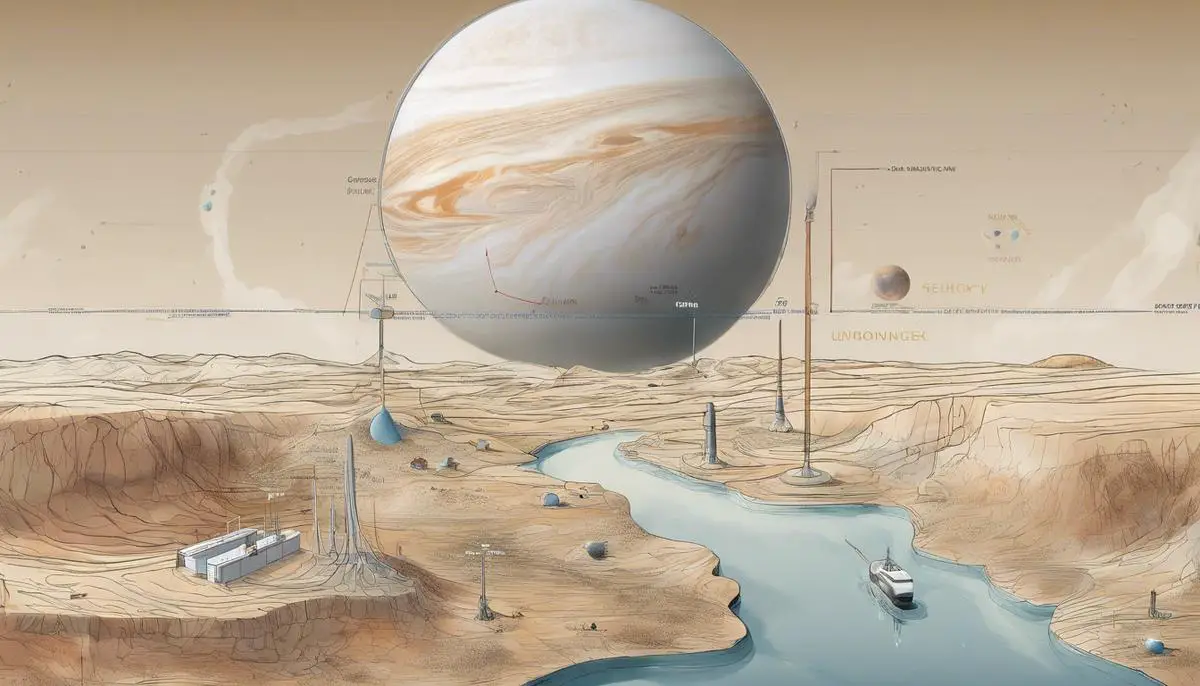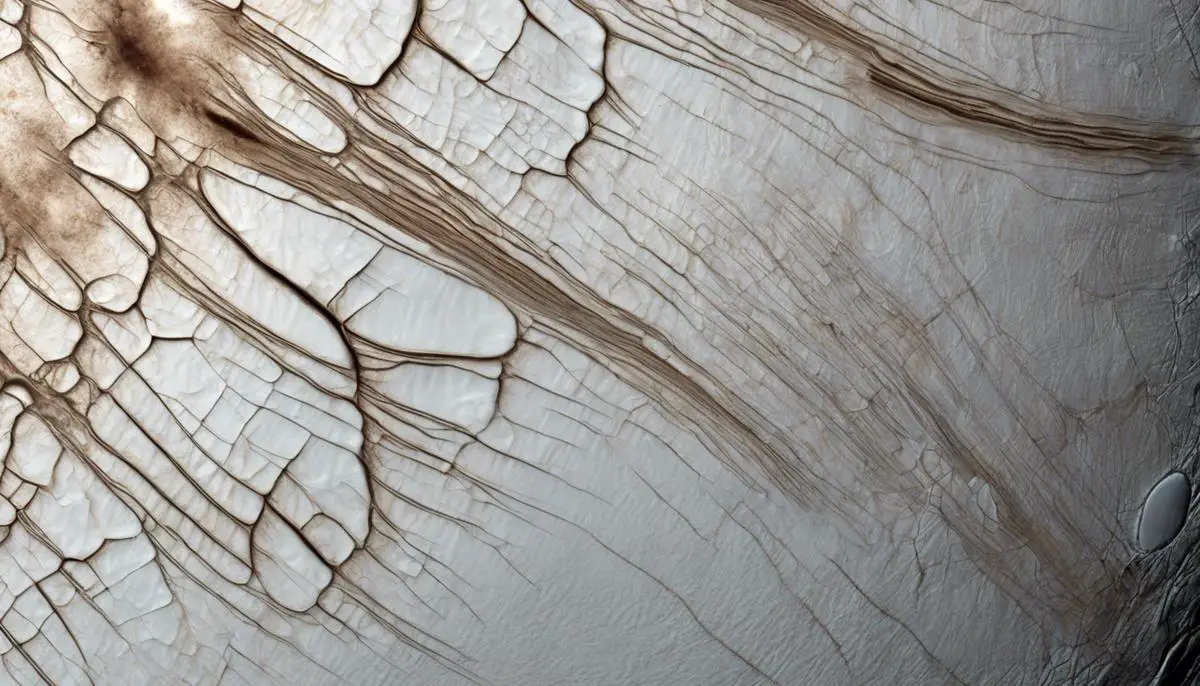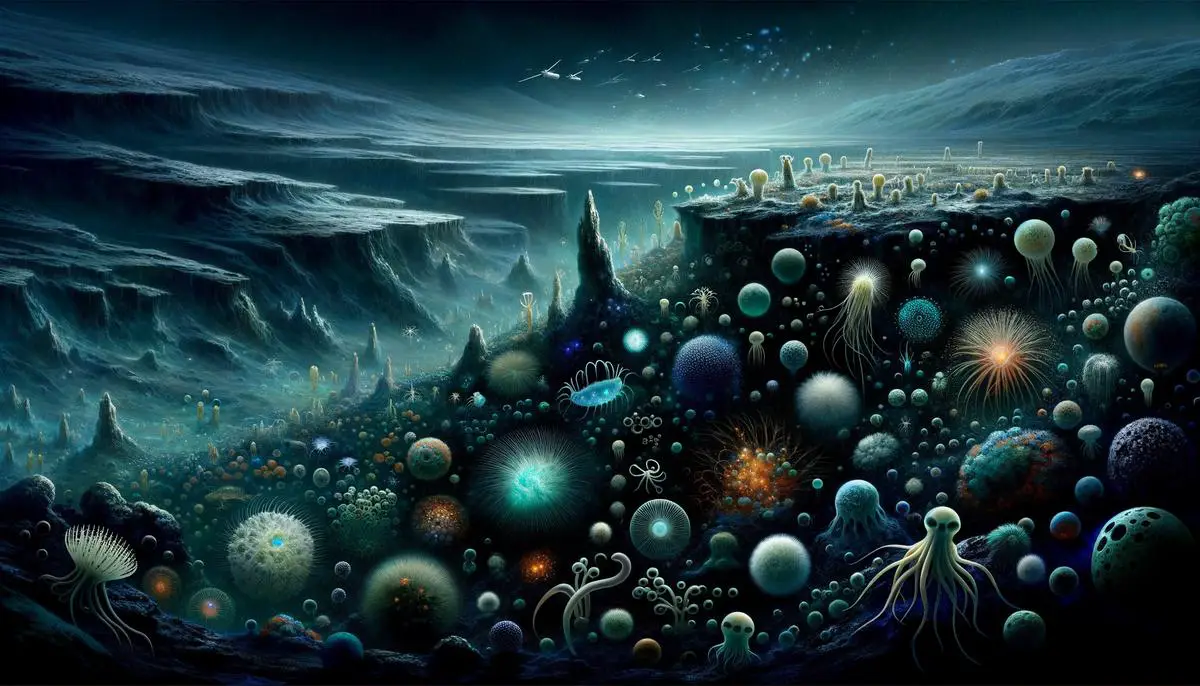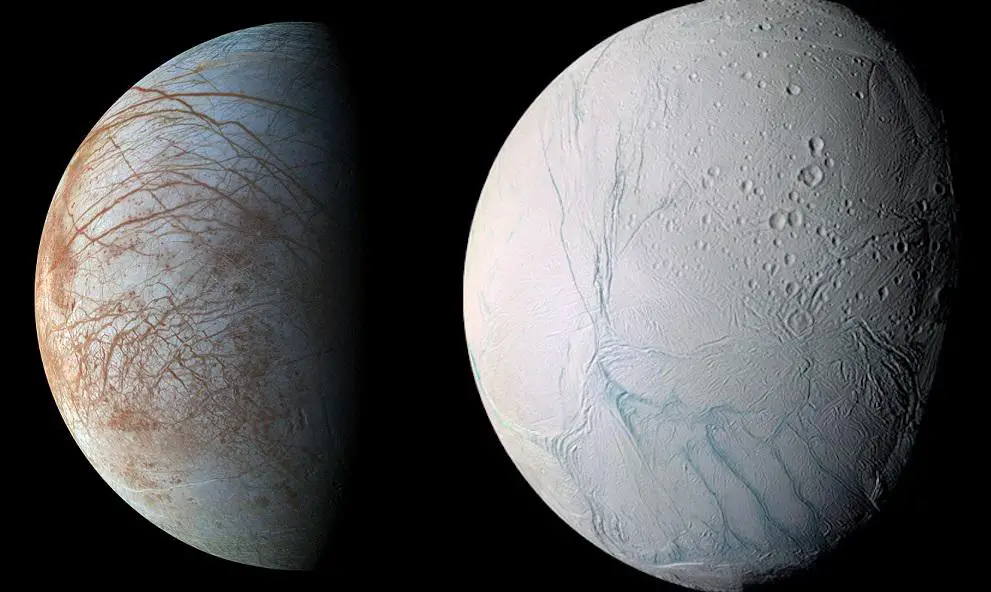Jupiter's moon Europa stands as a testament to the solar system's capacity for wonder, harboring a vast ocean beneath its icy crust that may challenge our understanding of life's potential beyond Earth. This celestial body invites us to consider the possibilities of extraterrestrial life in environments far removed from the sunlit worlds we are accustomed to.
Europa’s Ocean
Scientists have long been captivated by Jupiter's moon Europa because beneath its icy surface lies a vast ocean that could contain salty liquid water, much like Earth's oceans.
This subsurface ocean could stretch hundreds of miles deep—deeper than any ocean on Earth. Europa's ocean, hidden beneath a thick layer of ice, is likely brimming with salt, which is crucial for many biological processes as we know them.
The potential for life in Europa's ocean is intriguing due to the possibility of hydrothermal vents on the moon's ocean floor. On Earth, these vents host diverse communities of life forms thriving without sunlight. If Europa's ocean harbors similar vents, they could provide the necessary energy and minerals to support life.
Evidence for Europa's subsurface ocean comes from missions like NASA's Galileo spacecraft, which orbited Jupiter and its moons in the late 1990s and early 2000s. Galileo's observations suggested a magnetic field around Europa, indicating a salty, conductive ocean beneath its icy shell. Additionally, the Hubble Space Telescope observed water vapor plumes erupting through Europa's surface, suggesting the moon is geologically active.
The concept of hydrothermal vents on Europa serving as hotspots for life is grounded in our understanding of Earth's deep-sea environments. These vent systems support diverse life forms, demonstrating that life can thrive in extreme conditions. If Europa has its own version of these vents, unique ecosystems could be thriving in its alien ocean.
Studying Europa's ocean broadens our search for life beyond Earth and challenges our understanding of where life can exist in the cosmos. The possibility of life beneath Europa's icy surface is an exciting prospect for scientists and space enthusiasts alike.

Atmospheric Composition
Europa's thin atmosphere, dominated by molecular oxygen (O2), reveals the moon's dynamic nature. However, this oxygen is not produced through biological processes, as on Earth. Instead, it results from ice on Europa's surface being split into hydrogen and oxygen due to intense solar radiation, with the lighter hydrogen escaping into space.
While Europan organisms might not inhale this oxygen as we do, its availability could play a crucial role in chemical processes that support life. It indicates a surface and subsurface environment constantly altered by radiation, creating a potentially habitable niche for life as we know it or perhaps even more exotic forms.
The atmosphere's responsiveness to external influences, such as Jupiter's powerful magnetic field, offers glimpses of Europa's electrodynamic relationship with its parent planet. The interaction between the atmosphere and Jupiter's magnetosphere results in stunning auroras, observed as glowing ribbons encircling the moon's poles. These light shows provide clues about the composition and dynamics of Europa's atmosphere and its exchange with the surface below.
The exchange mechanism between Europa's surface and atmosphere has implications for the subsurface ocean's composition and the potential for life. Materials, potentially including organic compounds, might be transported from the surface into the depths through cracks in the ice, fueled by tidal forces exerted by Jupiter's gravity. This could create a diverse chemical environment conducive to life.
Europa's atmosphere bridges the icy surface with the hidden ocean, hinting at ecosystems as finely balanced as those found in Earth's depths. As we study this enigmatic world's atmosphere, we broaden our horizons about what it means to be home to life—challenging us to imagine life forms nurtured beneath a canopy of ice, in a realm where light fades into darkness.
Energy Sources
In the absence of sunlight, potential life on Europa would need to rely on alternative energy sources. Tidal heating, radioactive decay, and chemical energy from hydrothermal vents are key factors that could support life in Europa's subsurface ocean.
Tidal heating occurs due to Europa's elliptical orbit around Jupiter. As Europa traces its path, Jupiter's immense gravity stretches and relaxes the moon, creating internal friction that generates heat. This process may maintain the subsurface ocean's liquid state, providing a warm environment capable of nurturing life.
Radioactive decay within Europa's rocky core could also contribute to the moon's internal warmth. Just as Earth's interior is warmed by the decay of radioactive elements, Europa too may harness this energy source, adding another layer to its potential habitability.
Most intriguing is the prospect of hydrothermal vents on Europa's ocean floor. On Earth, these vents support thriving communities of organisms that rely on the chemical-rich fluids they emit. The vents convert cold, oxygen-poor water into energy-rich broths, drawing life into the dark recesses of our oceans. If similar vents exist on Europa, they could create niches where life may flourish, fueled by the chemical bounty forged in the moon's watery abyss.
The interplay between tidal heating, radioactive decay, and chemical energy from hydrothermal vents paints Europa as a world where life could exist without relying on solar energy. These processes could create diverse ecosystems, extending our understanding of life's potential beyond Earth-like conditions.
As we explore Europa's energy sources, we inch closer to unveiling its secrets and discovering that life in our solar system may not be limited to sun-dependent environments. Europa's internal fires and potential chemical feasts laid out by underwater vents offer tantalizing possibilities for the existence of life in the darkness beneath its icy surface.

Challenges to Life
Despite the allure of Europa's potential for hosting life, the moon presents formidable challenges for the survival of organisms. Three major obstacles stand out:
- The intense radiation from Jupiter
- The extreme cold
- The thick ice shell separating the ocean from the surface
Jupiter's powerful radiation belt bombards Europa with a constant stream of charged particles, capable of damaging molecular structures and genetic material. This radiation poses a significant threat to life as we understand it. However, Europa's thick ice shell may act as a protective shield, absorbing much of the radiation before it reaches the ocean below.
The penetrating cold on Europa creates an environment far removed from Earth's temperate conditions. Extremely low temperatures could slow down or halt biochemical reactions, challenging conventional notions of metabolic processes. Yet, life's adaptability, as seen in Earth's ice-locked habitats and extremophiles, suggests that organisms might evolve mechanisms such as antifreeze proteins to cope with the cold.
The thick ice shell also acts as a barrier, potentially limiting the exchange of essential nutrients and energy sources between the surface and the subsurface ocean. This isolation raises questions about the ocean's ability to support life. However, the observed water vapor plumes on Europa hint at the possibility of communication between the ocean and the surface, potentially serving as conduits for the transfer of materials.
While Europa presents significant obstacles to life, it also showcases the potential for unique adaptations and survival strategies. Just as life on Earth has demonstrated resilience in the face of adversity, hypothetical Europan life forms might harness the moon's challenging elements to carve out niches of existence.
Exploring Europa's potential for life involves navigating a complex interplay of radiation, cold, and isolation imposed by the ice shell. Yet, these challenges also underscore the moon's capacity for harboring mysteries and the possibility of life's persistence in the face of cosmic adversity. As we continue to study Europa, we seek to understand how life might overcome these hurdles and thrive in the depths of this intriguing world.
Future Missions and Research
The celestial dance between curious minds and the mysteries of the Cosmos continues as humanity casts its gaze towards Europa, a moon that beckons with the promise of undiscovered wonders deep within its icy shell. At the forefront of this cosmic exploration is the much-anticipated Europa Clipper mission, a herald of human ingenuity and the embodiment of our desire to reach out into the unknown.
The Europa Clipper, spearheaded by NASA, is poised to embark on a groundbreaking journey to Jupiter's moon, with a slated launch in the forthcoming years of this decade. This mission aims to conduct a detailed reconnaissance of Europa's ice-covered ocean and its potential for supporting life. Armed with a suite of sophisticated scientific instruments, the spacecraft is designed to swoop close to Europa's surface, coursing through the moon's scant atmosphere and skimming mere 25 kilometers over its icy crust at its closest approach.
The Clipper's primary scientific objectives include:
- Assessing the ocean's salinity, depth, and interaction with the moon's rocky mantle—factors pivotal in determining the ocean's habitability
- Examining the composition of Europa's icy shell, mapping its thickness, which veils the ocean beneath
- Scrutinizing the surface in detail, searching for signs of recent geological activity and any material ejected from the subsurface ocean through cracks in the ice or plumes spotted by previous observations
Equipped with ice-penetrating radar, infrared spectrometers, and high-resolution imaging systems, the Europa Clipper aims to pierce through Europa's frosty exterior. These instruments are extensions of our senses, reaching out across the void to analyze a world that has, until now, existed only in our imaginations and telescopic glimpses.
The excitement surrounding the Clipper mission is tempered by an acknowledgment of its limitations. As revolutionary as this mission promises to be, it stops short of definitively answering whether Europa is home to life. This torch will have to be passed on to subsequent missions, which may include a lander or even a sub-ice probe designed to directly sample the icy surface or access the ocean itself.
The concept of a lander mission rests on the proposition of touching Europa's alien ground, conducting in-situ analyses of its composition, and directly searching for biosignatures or even life forms in the ice. Further into the horizon glimmers the prospect of a sub-ice probe, a machine that could drill or melt through kilometers of ice to sample Europa's ocean directly—a feat that would represent one of the boldest endeavors in space exploration.
Through these future missions, humanity stands on the precipice of monumental discoveries. Each spacecraft we send, instrument we deploy, and byte of data we collect brings us closer to answering age-old questions about life's tenacity and ubiquity in the Cosmos. Europa, with its hidden ocean and potential secrets locked beneath its icy shroud, stands as a beacon in this search—a call to which we must respond with our best efforts in exploration and discovery.
The journey ahead is fraught with challenges and uncertainties, but it is propelled by the drive of curiosity, determination, and hope. As we chart our course towards Europa and the mysterious worlds beyond, we carry with us the virtues of the pursuit of knowledge and the hope that somewhere out there in the vast expanse, we are not alone. The answers we seek may lie beneath layers of ice and oceans deep, but our resolve to uncover the truths of our universe remains undiminished, guiding our voyage into the unknown.

The study of Europa's hidden ocean is not merely an academic pursuit but a journey into the possibilities of life's existence in the cosmos. The notion that this distant moon could host an environment conducive to life redefines our search for extraterrestrial beings, reminding us that the universe may harbor secrets in unexpected places.

![]()
